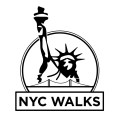The Brooklyn Bridge: The Eighth Wonder of the World

Scott Fitzgerald called Manhattan Island the “fresh, green breast of the New World” that greeted the sailors on Hudson’s Half Moon. The colonists wasted no time in proceeding with an aggressive program of land-clearing and filling.
The Brooklyn Bridge IS New York City. More than the Statue of Liberty, which we have to share with those guys over in New Jersey; more than the Empire State Building, which we have to share with the rest of America; more than the United Nations, which we have to share with the rest of world C the Brooklyn Bridge IS New York City.
Actually, there is a New Jersey connection to the bridge. John Augustus Roebling considered Trenton, the capital of New Jersey to be his hometown, and spent a great deal of time there during
The Brooklyn Bridge is a marvel of financing, engineering and beauty. When it opened in 1883, it was considered the eighth wonder of the world C and as far as I am concerned it still is. In 1883, it was the longest bridge ever to span a river C more than a mile long. It was the first bridge to be illuminated by electricity at night from its own power plant on the Brooklyn side. It was the first to use galvanized steel in its main cables. The construction of the Brooklyn Bridge was considered to be on the magnitude of the building of the Suez Canal and the Trans-Continental Railroad. In fact, both were finished in shorter periods of time than the Brooklyn Bridge.
Part II: Builder of the Brooklyn Bridge: John August Roebling, the Father

You may ask, why was the Brooklyn Bridge built? John Augustus Roebling was the financial, the artistic, and the engineering genius who constructed the Brooklyn Bridge. Roebling was a man of action. With the help of his family, he transformed other people’s dreams into reality.
How did Roebling come to construct this huge marvel? One day in 1852, when the only way to cross the river was by boat, the ferry Roebling was riding got stuck in the ice. While others cursed, Roebling planned a solution. Roebling was the first engineer to propose a bridge across the waterway. The roadway would go through the heart of both cites and connect New York City Hall to the Brooklyn Navy Yard. The walking promenade would “allow people of leisure and the young to stroll over the bridge on fine days.” Roebling sent his proposal to Abram Hewitt, a great business leader, and a future mayor of New York City. Hewitt publicized the plan. William Cruz Murphy, the former mayor of Brooklyn and the publisher of the Brooklyn Eagle championed the idea. The editor of the newspaper, Walt Whitman, had previously pleaded for a bridge across the East River.
Above all, Roebling loved a challenge. This bridge had to be the tallest, the strongest, the longest, and the finest in the world. The East River is a turbulent tidal strait connecting Upper New York Bay with Long Island Sound. The bridge would have to be so tall that only a few ships would have to trim their sails on one of the busiest waterways in the world. During the 13 years it took to build the bridge, maritime traffic was never interrupted.
Finally, the New York politicians got their act together. In the harsh winter of 1867, when the East River was choked with ice, the New York State legislature chartered the Brooklyn Bridge Company, later renamed the New York Bridge Company, to build the bridge. William Murphy became the president of the Board of Trustees. On May 23, 1867, John Roebling was appointed chief engineer by the company he had created.
You may ask who was John Augustus Roebling? He was born in Germany in 1806, and from his early youth engineering and bridge-building animated his passions. At the Royal Polytechnic Institute of Berlin, his philosophy professor, Frederick Hegel, recommended that Roebling learn English. As tradition and bureaucracy would prevent Roebling from ever building bridges in Germany, the young man decided his future lay abroad, and in 1831 he departed for America.
Roebling, from the very beginning, advocated designs and materials to build strong bridges. Not one of the bridges he built ever fell down. This was a real accomplishment because one out of four American bridges built between 1840 and 1880 collapsed. The oldest standing American suspension bridge is the one built by John Augustus Roebling in 1848 near Port Jervis, New York. It is now part of Delaware National Historic Recreation Area. Roebling helped make America the land of great suspension bridges where most of the world’s suspension bridges are found.
His company, John Roebling & Sons, became the foremost manufacturer of cable in America. In 1841, Roebling invented “iron rope” or cable to replace the hemp rope that had previously been used. Roebling eventually had eleven patents to his credit. Bridges mines, and railroads demanded what he made. His company spun the cable for the George Washington Bridge, the Williamsburg Bridge, the Manhattan Bridge, and the Golden Gate Bridge. He set up his factory in Trenton, New Jersey, which he considered his hometown. In turn, the City considered him its hometown hero. His statue stands in Cadwalader City Park of Trenton to this very day. People remarked that the statue looked exactly like Roebling’s son, Washington Augustus. But then it should, because it was he who had posed for the statue.
On June 24, 1869 while surveying the shores of the East River for the exact site to begin construction, Roebling sustained fatal injuries. He was so busy scouting the area that his toes became trapped between the ferry and the landing. John Roebling died from gangrene and tetanus a few days later.
